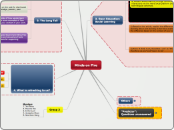IDEA
Part C
EAHCA
The Amendments were made in 1986, they required IFPs (intensive Family Preservation Services) for eligible children and their families, and there was a created federal financial incentives to provide education for early interventions from birth through age 2.
The EAHCA provided federal funding to states to assist them in educating students with disabilities. If the bureau approved the plan, the state was obligated to guarantee a FAPE to students in return for the federal funding it would receive.
The Education for All Handicapped Children Act was signed as a law in November 1975, the 142nd bill passed by the 94th Congress.
Part B
Parent Participation
Parents should be involved in the evaluation, IEP meetings, and placement decisions. The goal is to have them play a meaningful role in the education of their children and to maintain a partnership between school and families.
Zero Reject
All students with a disability have a right to a FAPE, without exception. This is when Child Find applies, the students have to be identified, located, and evaluated, regardless of their disability. The school must be determined if their disability is under IDEA.
Least Restritict Environment
LRE states that students in special education can only be removed to separate classes or schools when the nature or severity of their disabilities is such that cannot receive an appropriate education in a general education classroom with supplementary aids and services.
Personnel Development
To receive funds from the state, school districts must also provide a description of the personnel they will need to ensure a FAPE for all students with disabilities. This personnel should be trained and retained as highly qualified.
Technology-Related Assistance
Assistive technology devices and services should be included in IEP if necessary to provide FAPE as a special education service or a related service or to maintain children and youth with disabilities in the LRE through the provision of supplementary aids and services.
Procedural Safeguards
This is designed to protect students with disabilities interests. The parents of students should sign an informed consent, which is authorization to initiate the evaluation to see if the student needs to be placed or not.
FAPE
Free Appropriate Public Education which ensures that all students with disabilities have a right to an education. Schools should provide special education and related services to eligible students at no cost.
It addresses educational requirements for students ages 3 through 21. Also, it includes procedural safeguards designed to protect the interests of children and youth with disabilities.
Part A
Purpose of the IDEA
IDEA can be eligible from 3 to age 21 for special education. Although the states are required to provide services from birth to 21.
ensures that all children with disabilities have available to them a FAPE that emphasizes special education and related services designed to meet their unique needs and prepare them for further education, employment, and independent living, to ensure that the rights of children with disabilities and parents of such children are protected, to assist states, localities, educational service agencies, and federal agencies to provide for the education of all children with disabilities.
IDEA helps the children with disabilities to not only have the important to succeed in education but also to succeed after in finding a job, and to live independently. What happens if a person needs help after they turn 21? Do they receive other services?
Main goal of IDEA is to make sure the all the students can have progress in their education.
ESEA
Elementary and Secondary Education Act, enacted in 1965, and then the amendments in 1966, the federal government began to provide funding in states to assist efforts to educate students with disabilities through various grant programs.
EHA
In late 1975 the congress reported that during the 70s there was approx. 1.75 million students with disabilities were excluded from public schools and 2.2 million were educated in programs that did not meet their needs.
In 1970, the Education of the Handicapped Act was signed into law. In 1972 there were PARC vs Pennsylvania, and Mills vs Board cases, which contributed to the amendments in 1974. They consolidated full education opportunities, procedural safeguards, and education at least in restricted environments for students with disabilities.
Part D
Subpart 1, 2, 3
Support to establish parent training and information centers, also a community parent resource centers, provides technical support to parent training and information centers, use devices and strategies to make technology for students with disabilities.
Provides federal support for training, and technical assistance, develops and implements model demonstration projects to promote the use of scientifically based instructional practices, research to improve educational programs for students with disabilities, funds national programs that provide technical assistance, investigates and implements interim alternative educational settings, preventing problem behavior by using behavioral interventions and supports.
Personnel development and professional development are necessary to improve results for children and youth. This subpart authorizes formula grants that are given to states that apply and meet with school districts and institutions of higher education.
Its purpose is to make sure to fun activities that improve the education of children and youth with disabilities with qualified personnel.
While I was reading this part I got surprised at how the federal support got stronger in a way that they ensure that qualified personnel needed to hire qualified teachers. Also, to make sure that these people would assess all thirteen categories too, this means that no matter the disability, the students would get someone to help them out in their learning.
Funding the IDEA
President Ford signed the Education for All Handicapped Children Act which guarantees access to a FAPE in LRE to every child with a disability. This law promised that the federal government would cover 40% of the extra cost of special education.
Amendments
IEP
In order to have the students placed in IEP, there a process that needs to be follow.
Subtopic
The IEP process helps the student to make sure that a student might have a disability, also if it needs special education or if the disability is affecting their education. Most important, Parents have to be involved within the decision that is going to take place.
Disciplining Students in Special Education, and Manifestation Determination
School officials were allowed to discipline a student with disabilities in the same manner as they disciplined students without disabilities, with a few notable exceptions. A suspension should not exceed 10 school days, and 45 days if the students bring a harmful weapon with really good evidence.
How it become IDEA?
In 2004, they defined a "highly qualified" special education teacher, removed the short-term objectives requirement from IEPs (except for students with severe disabilities), and also encouraged the use of a response-intervention model to determine if students are learning disabled.
In 1997, they added new IEP contents and changed the IEP team, also new disciplinary provisions, and reorganized the structure of the IDEA.
In 1990, EAHCA was renamed the IDEA. They changed to "people first" language, they added a transition requirement to the IEP for student age 16 or older, and also brain injury and autism as new disability categories under the IDEA.
Who is Protected?
In order to define if a student is eligible for special education is made on an individual basis by the multidisciplinary team in accordance with guidelines set forth in the law.
Not all students with disability are protected; only those students with disabilities in the 13 categories of IDEA, and only if those disabilities have an adverse impact on their education, are eligible to receive a special education.









